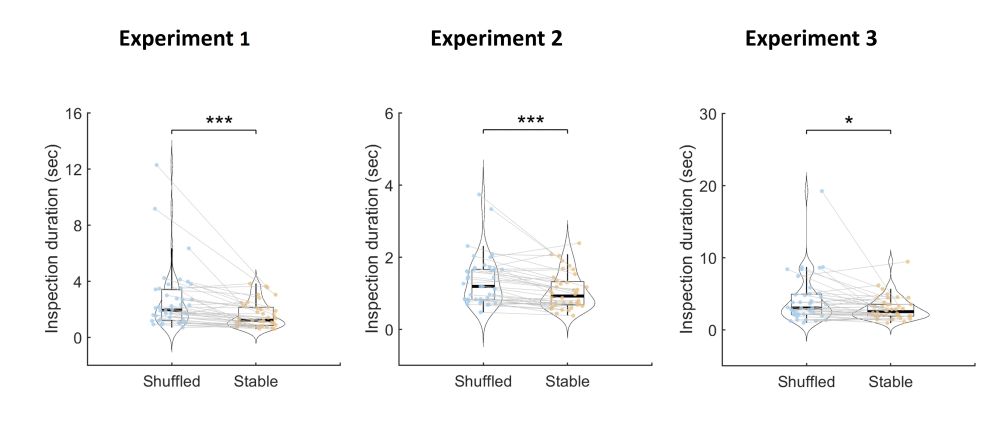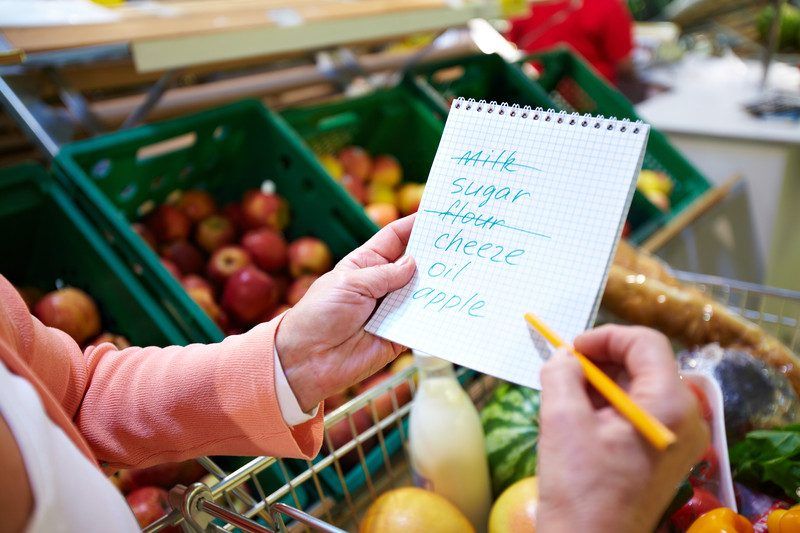Thank you, Sebastiaan!😀🎉
29.05.2025 03:56 — 👍 0 🔁 0 💬 0 📌 0
If you're interested in this article, here's the link: trebuchet.public.springernature.app/get_content/... Thanks to my supervisors @suryagayet.bsky.social @chrispaffen.bsky.social and @Stefan Van der Stigchel for their support!🎉
23.04.2025 03:23 — 👍 11 🔁 4 💬 1 📌 0
Congrats to Luzi @luzixu.bsky.social! We're very proud of you! 🎊
19.03.2025 13:01 — 👍 4 🔁 1 💬 0 📌 0
Once you eventually select those other times for your next round of search, they are encoded more efficiently thanks to these memory traces.
08.01.2025 10:32 — 👍 0 🔁 0 💬 0 📌 0
In sum, when you are repeatedly checking your shopping list for the next two/three items to search for, through visual exposure, you build up latent memory traces for the other items on your list as well!
08.01.2025 10:32 — 👍 2 🔁 0 💬 1 📌 0
We found that inspection durations were again shorter in the stable condition when observers were placing the last four items. Here, differences in sampling duration could only be attributed to prior visual exposure to the last four items (and not to e.g. visual distractions caused by swapping).
08.01.2025 10:32 — 👍 1 🔁 0 💬 1 📌 0

In Exp. 3, observers were asked to place four cued items (indicated by thick black outlines) first, and four uncued items later. We manipulated the stability of the last four items (uncued items)only while participants placed the first four (cued items).
08.01.2025 10:32 — 👍 1 🔁 0 💬 1 📌 0

Across 3 experiments, we found that when to-be-placed items were stable, observers took less time to sample them when they were selected for action later. This indicates that -through visual exposure- memory traces build up for prospective items, facilitating subsequent encoding.
08.01.2025 10:32 — 👍 2 🔁 0 💬 1 📌 0

In the SHUFFLED condition, we randomly swapped the locations of to-be-placed items before participants accessed the Model grid, which should interfere with the build-up of memory traces for unplaced items.
08.01.2025 10:32 — 👍 2 🔁 0 💬 1 📌 0
In the STABLE condition, the to-be-placed items remained at the same location throughout a trial, allowing for the build-up of memory traces for these unplaced items through repeated visual exposure.
08.01.2025 10:32 — 👍 2 🔁 0 💬 1 📌 0
Akin to the shopping list example, it is difficult for observers to memorize and place all items in one go. Therefore, participants need to revisit the Model grid, and are frequently visually exposed to items that are not yet selected for immediate action.
08.01.2025 10:32 — 👍 1 🔁 0 💬 1 📌 0

We asked whether memory traces are formed for these prospective (non-selected) items. To this end, our participants were tasked to reproduce a model grid (left) by dragging items from a resource grid (right) to their correct positions in the workspace (middle).
08.01.2025 10:32 — 👍 1 🔁 0 💬 1 📌 0

For instance, when using a shopping list, we may select a few items for immediate action, while being passively exposed to other (prospective) items on the list.
08.01.2025 10:32 — 👍 1 🔁 0 💬 1 📌 0
In our daily lives, we often encounter visual objects that we do not act on immediately, but are nonetheless exposed to, and may engage with in the future.
08.01.2025 10:32 — 👍 1 🔁 0 💬 1 📌 0

🎉New paper out in JEP:HPP with@andresahakian.bsky.social @suryagayet.bsky.social @chrispaffen.bsky.social and Stefan Van der Stigchel. We asked whether memory traces are formed for items that have not yet been selected for immediate action, while we are actively sampling targets for imminent action.
08.01.2025 10:32 — 👍 25 🔁 7 💬 2 📌 1
MSc student & research intern at attentionlab UU ☀️ Interested in (disorders of) attention & visual perception & consciousness
Trainee Board of The Mathematical Cognition and Learning Society.
We represent undergraduate and graduate students, postdocs, teachers, and other trainees.
Using large-scale experiments to study perception and cognition, working at The Chinese University of Hong Kong.
Neuroscientist at the crossroads of vision, cognition, and computational neuroimaging.
Director, Spinoza Centre | PI, Netherlands Institute for Neuroscience | Professor, Vrije Universiteit Amsterdam | sergedumoulin.net
PhD Candidate interested in visual attention and memory | Utrecht University | AttentionLab @attentionlab.bsky.social
PhD Candidate in Artificial Intelligence and Cognitive Neuroscience | Investigating how AI can help understand the brain | Utrecht University | COBRA & AttentionLab
Scientific journal of the American Psychological Association, publishing research relating to the functional understanding of perception and action. Celebrating our 50th anniversary!
https://www.apa.org/pubs/journals/xhp
Computational cognition. Vision. Working memory.
Incoming CNRS ISC (postdoc); University of Maryland (PhD); Peking U (BS&BA). Interested in shared and unique computations cross language and vision, with EEG/SQUID & OPM MEG/.... Personal website: https://sites.google.com/view/xinchiyu/home
cogsci.nl/smathot Cognitive psychologist interested in perception, attention, and pupillometry. Developer of OpenSesame and other open-source scientific software. Writer of short stories (suchwasnot.com) and non-fiction (Een wereld vol denkers).
Working Memory Researcher at U. of Geneva
#workingmemory
Cognition and Cognitive Development
PI of the WomCogDevLab
Steering board Swiss Reproducibility Network
CIHR Postdoc Fellow at Montreal Neurological Institute (MNI) | PhD in Cognitive Neuroscience, @mrccbu Cambridge | Cognitive control, Attention, MDN/DMN | Gates Cambridge Scholar
Professor of Cognitive Neuroscience at the FIL, UCL, using human neuroimaging to study how our prior knowledge influences the way we perceive the world. https://www.fil.ion.ucl.ac.uk/team/visual-perception-team/
Cognitive Neuroscientist in Amsterdam
proactivebrainlab.com
An online-only journal publishing Reviews, Perspectives & Comments across psychology, its applications & societal implications. Tweets from the editors. https://www.nature.com/nrpsychol/
Academic, cognitive & vision scientist, computational modeller, cofounder @neuromatch Academy, He/His. This is a personal account.
I'm a cognitive scientist and Professor of Psychology at UC San Diego. My lab studies visual cognition and memory. Website: https://bradylab.ucsd.edu/
The funder-researcher collaboration and open-access publisher for research in the life and biomedical sciences.
Follow @eLifeCommunity.bsky.social






